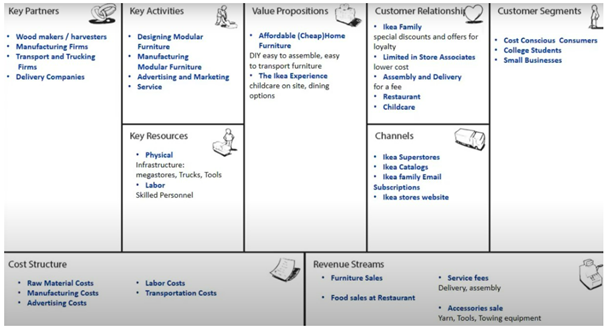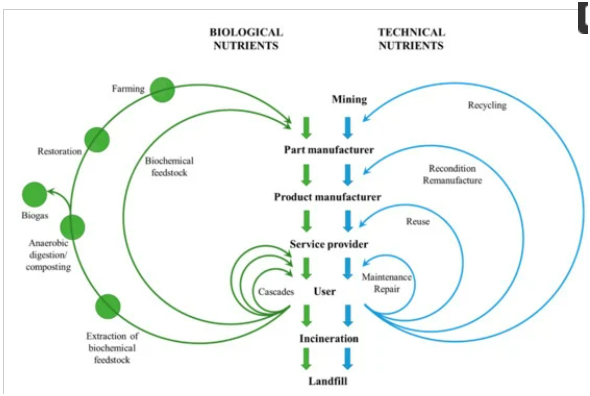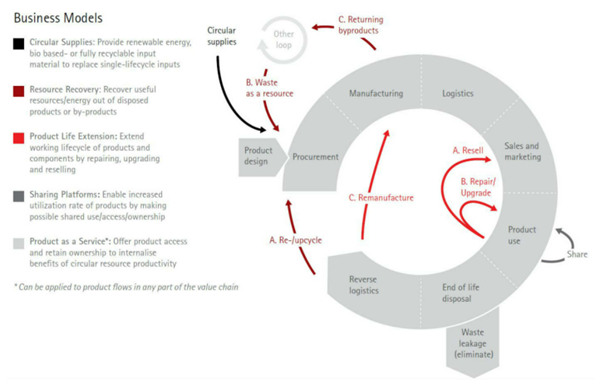Business Models Of Circular Economy Within IKEA
Question
Task:
You are required to write a 2000-word essay evaluating and suggesting improvements for circular economy practices within an existing organisation’s business model. In your essay you must:
• Critically evaluate the current business model in terms of its integration of circular practices and its sustainability. The business model does not have to be circular or sustainable. You should explain how the business model enables or creates barriers to using circular practices and show how this connects to sustainable or unsustainable outcomes.
• Propose ways to either integrate circular practices into the business model or, changes to make the use of circular practices more effective in terms of sustainability.
Your essay should have an introduction and a conclusion and follow a clear logical structure. Ensure that you fully address the bullet points above. You are encouraged to make use of figures and tables where appropriate to communicate your ideas. Rather than writing extensive paragraphs to explain an idea, it can be more effective to develop a diagram to explain something and then support this with a shorter section of text. This can help you to ensure that you do not exceed the word limit and allows you to demonstrate competency in using information technology for effective communication. You should make use of peer-reviewed academic literature. Lectures will introduce you to some relevant literature, but you are expected to read more widely and draw on this wider reading in your assignment. All citations and references should be formatted using the Harvard referencing system.
Answer
Introduction
The concept of circular economy in business has been adopted and used to great effect by different business companies that conduct their operations in the world market. Within a circular economy, waste matter is developed out of manufacturing products and the materials are maintained for utilisation in future. Different brands that operate in the market are incorporating the practices of circular economy effectively by adhering to the relevant market trends and practices. Circular value chains are coordinated with the use of data. Circular product design and its features are also made available for the companies in the world market.
The essay covers the business model that is followed by the IKEA company. IKEA company is a Swedish origin multinational conglomerate organisation that deals in designing and selling readymade furniture, kitchen appliances in the world market (IKEA.2021). The revenue model is being used by IKEA through the inclusion of the flat packaging modes with efficacy. The specific business model being adopted by IKEA aids the company to link up the sustainable practices that adhere to the circular economy in a planned way. By including the features of the circular economy, the IKEA company ensures that they can operate confidently in the market with enhanced productivity, profitability and accuracy.
Discussion
Critical evaluation of the present business model
IKEA company has a structured business model that it follows for maintaining the quality and efficiency of its key activities. The revenue model is followed by IKEA at present. The revenue model and its features had a positive impact upon IKEA as it guided them to design a framework that generates financial income in a positive and well-planned way in the global market. The revenue model that is adopted and applied within the world market by IKEA ensures that the value to be offered is decided and the pricing rate of the value gets specified in the world market for IKEA. The revenue model provides help to shape up the quality framework of business operations in the global market for IKEA by ensuring that sustainable standards and practices are practised properly. According to Singh et al. (2021), by aligning with the revenue model that is an integral part of the overall business model being framed by IKEA, the company popularised the flat packaging business concept that had made the furniture company design and make high-quality products in the world market.

Figure 1: Business Model Canvas of IKEA Company
(Source: Models and Model 2021)
The business model canvas pertaining to the IKEA Company gave a clear idea about its key partners which were the harvesters, manufacturing firms and delivery companies. The main activities were designing modular furniture and developing advertising and marketing operations. The affordable price rates of the furniture were provided as a value proposition. The college students and the customers who focused upon the importance of expenses was the prospective customers of IKEA. IKEA family provided special discounts and provided offers for designing loyalty services. The channels such as IKEA superstores and Catalogs were used. The different types of cost structure were developed.
Gilis Lundgren was one of the most efficient designers who had been associated with carving out more than 200 business designs linked to the products that were designed and sold to the customers. Flat packaging was supported as a business model by Lundgren as he designed and made a ready assemble chair that was suitable for use by the individuals living in the society. IKEA could strategically position their business by adhering to the flat packaging concept that helped them to grow from a small business that originated in Sweden to a large multinational organisation that carved out $30million as profits per year. By adopting and incorporating the flat packaging business model, the company ensured that the price rates of the quality furniture could be made more affordable in comparison to the market competitors because the company had offloaded the process of assembling to its buyers (Knock-down kit strategy to decrease vehicle assembly, 2021). The flat packaging concept is considered as the effective and logical business idea that could be applied by IKEA as it also supported the company to adapt to the sustainable practices and quality market standards that were perfectly applied. The stores and outlets that conduct their business operations under IKEA could adopt sustainable marketing strategies that would help them to maintain more stock in comparison to its competitors who exist within the globalmarket.

Figure 2: Types of Circular business models available in the world market
(Source: Greenbiz.com.2021)
The adoption of Flat packaging helped IKEA to transport and ship 10 times more products in the global market as compared to their normal shipping. The aesthetics that is designed and produced by the IKEA company were minimalist and clean that was effective. The flat packaging business model did include sustainable practices and also included the application of the sustainable trends that are present in the world market. According to Purnell et al. (2019), by using the flat packaging-based ideas, the furniture company could adapt to the resource recovery activity by which the company would devise a strategy for recovering the useful products from the disposed of products and services. Thus, IKEA company slowly transformed its business based on the circular economy model that enhanced its profits and carved out a bright future for the company(Klein et al. 2020).
A quality relationship is maintained by IKEA with its customers by the provision of assembled activities and designing delivery services. According to Ding et al. (2021), renewable resources could be used by IKEA in the form of raw materials that could be adapted to the quality marketing designs existing within the global market standards and conditions. Flat packaging products could be developed in the market that was easy and convenient to be dismounted. The relevance of the flat packaging concept provided much-needed support to the IKEA company and ensured that they could enhance their profits and achieve the productive goals that had been laid down. According to Dyllick and Rost (2017), the working lifecycle of the products that are designed and sold by IKEA is enhanced in the global market by adapting to the basic marketing strategy that is effectively applied for ensuring the achievement of the targets being framed. The flat packaging concept that was accepted as a universal business model by IKEA could be applied in a methodical way within the global market so that the well-defined goals could be achieved. Difficulties existed as the IKEA company slowly wanted to transform the ways by which their present business model operated in the global market. According to Dantaset al. (2021), the inclusion of circular practices within the execution of the business plans faced obstacles as most of the employees did not have quality information about the circular economy model and did not know the procedure to incorporate it within the furniture company.Dantaset al. (2021) opined that thespecific challenge of identifying and exploring a successful and well-planned circular business model was faced by the IKEA company as it had to establish the “win-win-win” successful setting. The specific setting would have enabled the furniture company to fulfil the interests of their stakeholders and transform their actions that could be applied as basic incentives for smoothly conducting businesses. The customer returns and the concept of reverse logistics were also affected by the transition of the existing business economy of IKEA to a circular economy model. Designing a supply chain in a closed-loop would help to enhance the life cycle of the products that are designed and sold in the global market by the IKEA company.
Changes adopted to make the use of circular practices more effective
According to Ferasso et al. (2020), circular business models that could be specified and found within the global market had guided the IKEA company to develop quality value from the waste products. The existing reverse flow that was aligned to transforming the present business model into a circular economy model was examined by adhering to the specific steps and beneficial practices. The consumers, different companies and the social factors that were involved in the designing of a circular economy helped in making the business practices clear and precise. Three categories of initiatives were assessed so that the obstacles that affected the transformation of the flat packaging business model to a circular economy business model could be developed by proper planning and precision. Firstly, the buy-back and tack-back operational services that were designed by IKEA had to be considered. Secondly, the offering that was designed after-sales parts had to be mentioned and lastly, the application of usership models of business also helped to specify the ways by which IKEA could restore their value in second-hand commodities.
According to Menz et al. (2021), sustainable competitive advantage could be achieved by the IKEA company in the global market by adhering to the well-defined and basic marketing objectives that are researched. The maintenance of customer convenience is a definite challenge for the IKEA company for inclusion and application of the return process. This would have an impact upon enhancing the return rate of the end of life and end of user commodities that exist. The commodities have to be introduced and separated very early in case of tackling transportation and handling that are included quite illogically within the global market by the IKEA company. According to Lahti et al. (2018), the designing of the products and the resource allocation could prove to be effective to be known earlier for transforming the present business model to the circular economy model of conducting business. The attitudes of the consumers have to be understood properly by IKEA as that would help the company to communicate the behaviour of circular economy with greater efficiency in the global market.
Borg et al. (2020) opined that quality customer communication is the biggest challenge as that has to be overcome by IKEA to get access to the knowledge of the attitude of the consumers associated with the second-hand commodities that are found. IKEA thus could achieve sustainable outcomes by dealing with the different challenges that are faced by the company and ensuring that the overall operations could be executed by transforming the present business model into a circular economy model.
Different ways can be found by which circular business model practices can be incorporated within the existing business model that is found in the global market(Lahti et al. 2018). The IKEA management has to design and specify the effective plans of conducting the business operations that would enable them to incorporate the sustainable practices that prove to be smooth and efficient in handling the unique range of tasks perfectly. The IKEA company is also required to develop an effective style of leadership that would make sure that the workforce is guided on the right track to deal with the change of business model of the economy to the circular business economy. The quality information has to be shared so that the essential products could be designed and marketed by adhering to fair strategies. According to Jia et al. (2019), the transformational leadership style proved to be suitable for the IKEA company as that would have helped them to make their employees trained perfectly so that they could perform well with clarity and greater efficiency that proved to be effective and useful.

Figure 3: Circularity Butterfly diagram to incorporate circular practices
(Source: Bianchini, Rossi and Pellegrini, 2019)
According to Lambin et al. (2020), IKEA would also make efforts in involving the communities and various cultural groups that ensures the adoption and application of sustainability practices in the global market by aligning with the basic standards and features. Circular practices such as recycling of the different materials would have to be adopted by IKEA. The basic inputs that are provided by the multidisciplinary teams would provide the necessary support to the IKEA company to ensure that the sustainable standards and practices could be established and made applicable with greater efficiency and success. The sustainable practices and the basic procedures of adapting to them have to be executed by IKEA.Biochemical feedstock has to be developed by the IKEA company to ensure that the well-defined business activities can be developed by adhering to the sustainable trends.
IKEA would have to transform their organisational and make sure that their employees are committed to executing their operations and strive towards being responsible for carving out a cleaner and healthier environment for the customers and other individuals living in the world. A sustainable marketing strategy that includes greener marketing practices needs to be incorporated by IKEA for ensuring the success of their operations.
Conclusion
The essay covered the topical elements that are associated with the adoption of the circular economy business model by different multinational companies. Out of the different companies that adopted the circular economy model of conducting business, the IKEA company and its operations were chosen. IKEA company followed the flat packaging concept of business but it had plans of transforming its business model to that of the circular economy. IKEA faced challenges for including circular practices. However, the largest furniture company operated with efficiency and achieved sustainable outcomes that satisfied the requirements of their customers and resulted in their productivity growth and increase in efficiency for designing and selling products.
Reference List
Borg, D., Mont, O. and Schoonover, H., 2020. Consumer acceptance and value in user-oriented product-service systems: Lessons from Swedish consumer goods companies. Sustainability, 12(19), p.8079.
Ferasso, M., Beliaeva, T., Kraus, S., Clauss, T. and Ribeiro Soriano, D., 2020. Circular economy business models: The state of research and avenues ahead. Business Strategy and the Environment, 29(8), pp.3006-3024.
Greenbiz.com. 2021. The 5 business models that put the circular economy to work | Greenbiz. [online] Available at:
Jia, F., Gong, Y. and Brown, S., 2019. Multi-tier sustainable supply chain management: The role of supply chain leadership. International Journal of Production Economics, 217, pp.44-63.
KD or Knock-down kit strategy to decrease vehicle assembly, d., box, J. and KD or Knock-down kit strategy to decrease vehicle assembly, d., 2021. How Ikea spread the flat-pack revolution across the world - Woodpecker. [online] Woodpecker. Available at:
Laurin, F. and Fantazy, K., 2017. Sustainable supply chain management: a case study at IKEA. Transnational Corporations Review, 9(4), pp.309-318.
Purnell, P., Velenturf, A.P.M. and Marshall, R., 2019. New Governance for Circular Economy: Policy, Regulation and Market Contexts for Resource Recovery from Waste. Resource Recovery from Wastes, 63, p.395.
Singh, P., Rao, K.S., Xuan, L., Kee, D.M.H., Min, F.J., Xuan, T.Y., Ing, T.S., Malhotra, K. and Pandey, R., 2021. Key Determinants of International Retail Success: A Case of IKEA Retail. International journal of Tourism and hospitality in Asia Pasific (IJTHAP), 4(1), pp.18-33.
Models, B. and Model, I., 2021. IKEA Business Model – StudiousGuy. [online] Studiousguy.com. Available at:
Klein, N., Ramos, T.B. and Deutz, P., 2020. Circular economy practices and strategies in public sector organizations: An integrative review. Sustainability, 12(10), p.4181.
Menz, M., Kunisch, S., Birkinshaw, J., Collis, D.J., Foss, N.J., Hoskisson, R.E. and Prescott, J.E., 2021. Corporate Strategy and the Theory of the Firm in the Digital Age. Journal of Management Studies, 58(7), pp.1695-1720. Bianchini, Rossi and Pellegrini, 2019. Overcoming the Main Barriers of Circular Economy Implementation through a New Visualization Tool for Circular Business Models. Sustainability, 11(23), p.6614.
Ding, D., Liu, X. and Xu, H., 2021, October. Sustainable Competitive Advantage: Case Studies of Dell, Ikea and Byte Dance. In 2021 6th International Conference on Modern Management and Education Technology (MMET 2021) (pp. 674-679). Atlantis Press.












